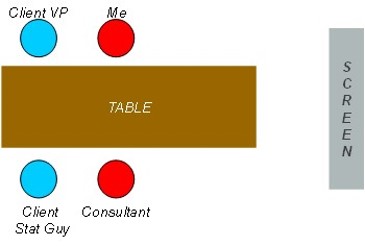Space....The Final Frontier

Have you ever noticed when you get in an elevator, strangers optimize space between them. You get in, press your number and step to the back corner of the elevator. Next person gets in, hits their number and steps to the back opposite corner. As more people enter, space is optimized by people standing as far away as possible from each other. Knowing this is the norm of human behavior, sometimes, I shake it up. I'll get in, push my button and stand dead center in the elevator. It's fun to see what happens next! Ah, Patrick the Disruptor!
In the field of Nonverbal Communication, the study of space is called Proxemics. When I took my graduate course in nonverbal communication, I was fascinated by … well … EVERYTHING! One HUGE takeaway from that course was an acute awareness about space.
Our use of space fills two opposing human needs: Affiliation or Privacy.
If we seek affiliation, we use space to encourage eye contact and feedback loops. If we seek privacy, we maximize our distance so eye contact is NOT made, conversation is curtailed … and we are left to our own thoughts. For instance, when you settle into your seat on a plane, do you indicate Affiliation or Privacy?
Discerning people's needs for Affiliation versus Privacy in any situation is both an ART and a SCIENCE! With just a little more awareness, we can increase our effectiveness and INFLUENCE in our interactions.
Ready to improve your Proxemics Expertise?
The use of space can facilitate an open dialogue or focus attention on a single person. For example, my annual Wisdom Council events are purposely arranged in Circle. There is no power position in a circle. All equal participants. People can make eye contact with anyone in the circle. We can watch nonverbals to receive information about how a person feels or when they are complete with their turn. At the other end of the continuum is Theater Style arrangements where all chairs focus to a single point – either the stage or the front of the room. Very little 'side-to-side' interaction occurs or is encouraged.
So, let me tell you a story…
I was in Berlin for client meetings with my consultant. She had done ALL the research and data analysis for this 2-day meeting. As leader for my team, I saw myself as backup to the high-value conversation between my consultant and the client's stat guy. On Day 1, the client was already in the room so I sat next to the VP and my analyst sat next to the stat guy. Makes perfect sense, right?
The conversation started with our presentation up on the screen and the Client VP asking me questions. I kept swiveling from VP to screen and back again. I tried to get the conversation going between the client stat guy and my consultant, but it just wasn't happening. All day long. Swivel. Swivel. Swivel. What to do?!?

That evening, I told my consultant I wanted her to really engage the conversation tomorrow. Of course, the next day, everyone took their same seats. When the client asked me the first question of the day, I stood up. Walked around the table in front of the screen BEHIND my consultant. I put my hand on her shoulder and answered the question….briefly. I asked my consultant to provide more detail. I stayed behind her for the next two questions. Until I wasn't saying anything.
Standing behind my consultant re-directed the conversation to go THROUGH her. Eye contact with HER. It also provided a symbolic gesture that I stood BEHIND my consultant, giving her credibility. Day 2 went INFINITELY better. Less of me swiveling around and getting dizzy. More of an effective working session. We took our meal in the room as we actively engaged the analysis.
Proxemics was EVERYTHING that day. With a simple conscious choice to CHANGE how space was being used, the trip to Berlin was a SUCCESS.
Lifting your awareness of how space directs conversation will make you much more intentional and effective in your interactions. Give it a try! At your next meeting, think about your objective and set up the room with that intention. Do you want to generate dialogue? Circle Up. Do you want to instruct? Focus to the Front. Then consciously observe what happens.
In meetings, my clients and teams got used to me sitting with my back to the white board. They would literally save me a chair. Why? Well, I talk with my hands and will inevitably be at the board, drawing pictures and diagrams. Providing information in multiple channels, auditory and visual, accommodates multiple learning styles. A colleague of mine called this, Chalk Talk. I wonder what century he learned that phrase? 😊
Okay. Before reading this blog, you were probably familiar with space and how it's used. You sit at the head of the table when you are the authority. You sit in the middle when you want to engage in conversation. However, the more you are aware, the more you learn and the more intentional you are to people's needs for Affiliation and Privacy. Your influence dramatically INCREASES with your awareness of Space.
Today we've just scratched the surface of Proxemics. I spent my CAREER learning and honing my skills around the Power of Proxemics.
Are you ready to engage?
LEARN DEEPLY




